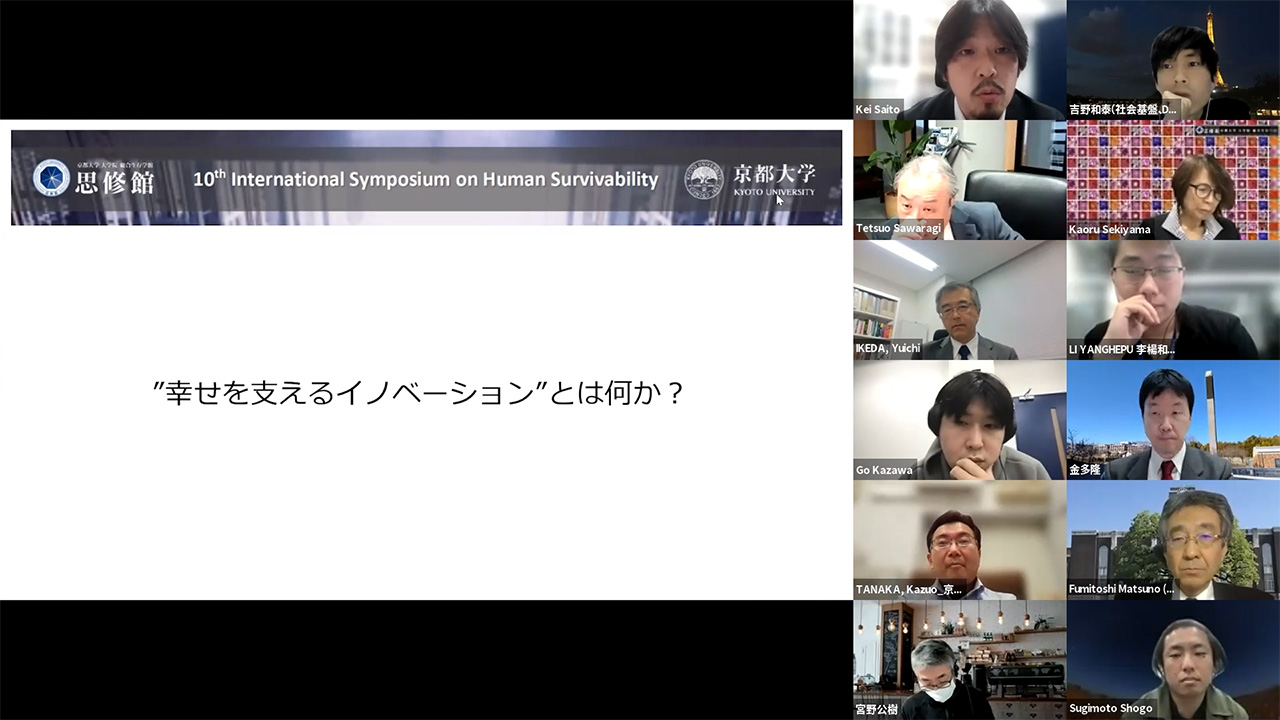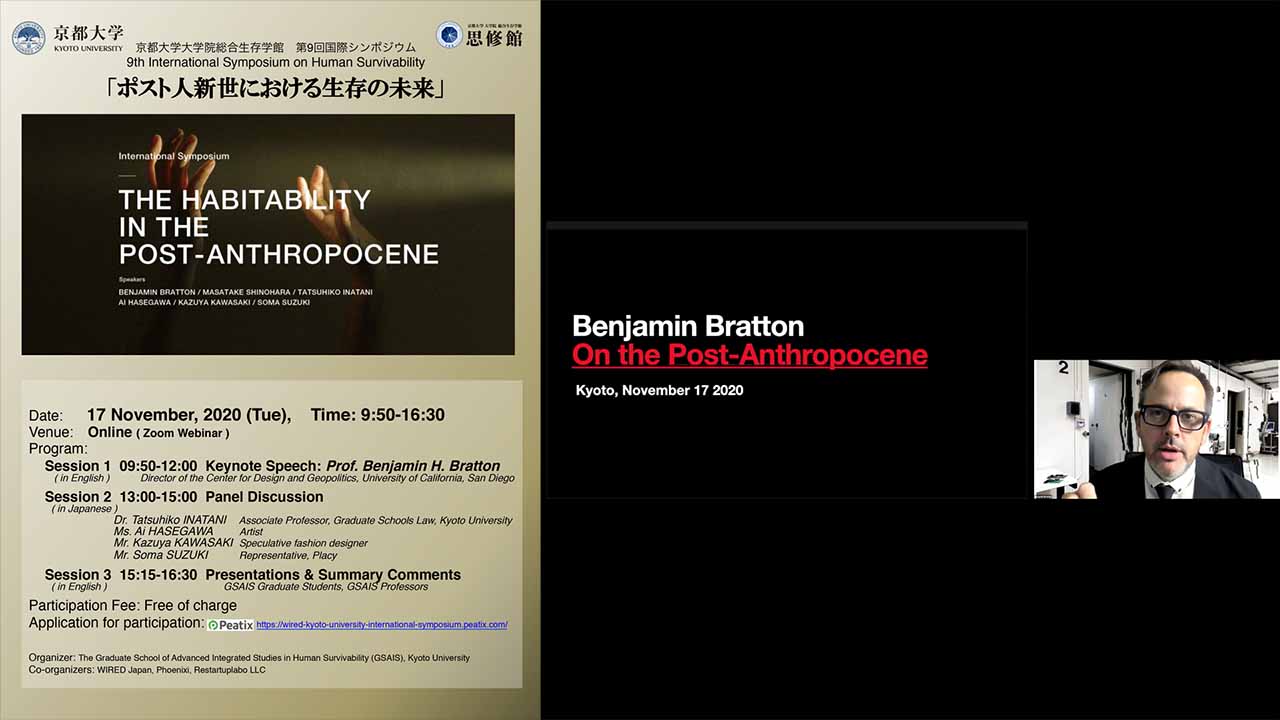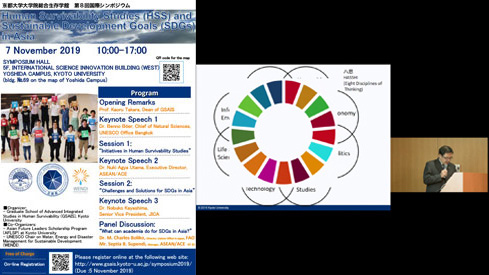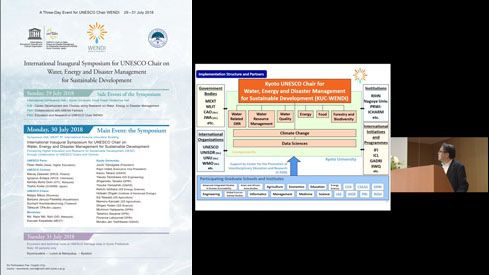Fifth International Symposium on Human Survivability “Disasters and Human Survivability: Enhancing Resilience to Risks Threatening the Future of Humanity”
Summary of Day 1 and preview of Day 2 Prof. Dimiter Ialnazov (GSAIS, Kyoto University; Head of the Organizing Committee)
Course Description
The main goal of the International Symposiums on Human Survivability is to provide a fresh look at the global challenges facing humanity in areas such as energy, water, food, population, diseases, etc. This year’s symposium will focus on enhancing resilience to extreme, or large-scale disasters that may threaten the well-being of present and future generations. We aim to develop a holistic approach that integrates various research fields by considering the past, present and future dimensions.
The symposium will bring together scholars from natural and social sciences, as well as humanities. The idea behind this is that we need to go beyond the “silo-based” approach, where handling disasters is something left to experts with specialized knowledge. The integration of the knowledge of scholars from different academic fields and backgrounds could be expected to provide some novel solutions to the problem of how to enhance our resilience to future disasters.
-

- Opening Speeches
-
Prof. Masao Kitano (Executive Vice-President, Kyoto University); Prof. Shuichi Kawai (Dean of GSAIS, Kyoto University); Moderator: Prof. Eriko Ishida Kawai (GSAIS, Kyoto University)
Nov. 22, 2016 22:32 English
-

- Keynote Lecture “A Classification of Risks Threatening the Future of Humanity”
-
Dr. Shahar Avin and Julius Weitzdoerfer (University of Cambridge, UK)
Nov. 22, 2016 49:24 English
-

- Discussion
-
-
Nov. 22, 2016 26:16 English
-

- Presentation about the main idea of the symposium and some concepts that will be discussed
-
Prof. Yosuke Yamashiki (GSAIS, Kyoto University)
Nov. 22, 2016 17:28 English
-

- Presentation 1 “Extreme Space Weather as an Emerging Risk”
-
Prof. Hiroaki Isobe (GSAIS, Kyoto University)
Nov. 22, 2016 23:58 English
-

- Presentation 2 “The 2011 Tohoku Earthquake and Tsunami: an Unexpected Disaster”
-
Prof. James Mori (Disaster Prevention Research Institute (DPRI), Kyoto University)
Nov. 22, 2016 21:45 English
-

- Discussion
-
-
Nov. 22, 2016 53:22 English
-

- Summary of Day 1 and preview of Day 2
-
Prof. Dimiter Ialnazov (GSAIS, Kyoto University; Head of the Organizing Committee)
Nov. 22, 2016 06:45 English
-

- Student presentations
-
General introduction by Prof. Marc-Henri Deroche (GSAIS, Kyoto University)
Nov. 22, 2016 43:22 English
-

- Past Session Introduction
-
Prof. Takura Izumi (GSAIS, Kyoto University)
Nov. 22, 2016 13:09 English
-

- Presentation 1 “How did people observe and describe extraordinary natural phenomena in the period of the Global Crisis?”
-
Prof. Satoshi Koyama (Graduate School of Letters, Kyoto University)
Nov. 22, 2016 28:24 English
-

- Presentation 2 “Lessons from the Global Outbreaks of Infectious Diseases in the Past”
-
Prof. Masao Mitsuyama (GSAIS, Kyoto University)
Nov. 22, 2016 43:26 English
-

- Discussion
-
-
Nov. 22, 2016 23:24 English
-

- General Introduction
-
Prof. Takashi Kanamura (GSAIS, Kyoto University)
Nov. 22, 2016 08:12 English
-

- Presentation 1 “The timing of investments for adaptation to climate impacted hazards”
-
Prof. Stefan Trück (Centre for Financial Risk, Macquarie University, Australia)
Nov. 22, 2016 51:21 English
-

- Presentation 2 “When should a CAT Index Futures be Created? Limits of Insurance Risk Securitization due to Basis Risk and Adverse Selection”
-
Prof. Kazuhiko Ohashi (Graduate School of International Corporate Strategy (ICS), Hitotsubashi University)
Nov. 22, 2016 32:16 English
-

- Discussion
-
-
Nov. 22, 2016 23:47 English
-

- Panel Discussion
-
-
Nov. 22, 2016 1:15:29 English
Details
- Year/Term
- 2016
- Date
- November 21st to November 22nd, 2016
- Faculty/
Graduate School - Graduate School of Advanced Integrated Studies in Human Survivability (GSAIS)
- Language
- English
[Program]
21 November, 2016
1 Opening Speeches
Prof. Masao Kitano (Executive Vice-President, Kyoto University)
Prof. Shuichi Kawai (Dean of GSAIS, Kyoto University)
Moderator: Prof. Eriko Ishida Kawai (GSAIS, Kyoto University) Video
2 Keynote Lecture “A Classification of Risks Threatening the Future of Humanity”
Dr. Shahar Avin and Julius Weitzdoerfer (University of Cambridge, UK) Video
3 Discussion Video
4 Presentation about the main idea of the symposium and some concepts that will be discussed
Prof. Yosuke Yamashiki (GSAIS, Kyoto University) Video
1. FUTURE Session
“What lies ahead? The risks of extreme disasters (high-impact, low-probability events) in the future”
5 Presentation 1 “Extreme Space Weather as an Emerging Risk”
Prof. Hiroaki Isobe (GSAIS, Kyoto University) Video
6 Presentation 2 “The 2011 Tohoku Earthquake and Tsunami: an Unexpected Disaster”
Prof. James Mori (Disaster Prevention Research Institute (DPRI), Kyoto University) Video
7 Discussion Video
22 November, 2016
8 Summary of Day 1 and preview of Day 2
Prof. Dimiter Ialnazov (GSAIS, Kyoto University; Head of the Organizing Committee) Video
Introduction to the student poster session
9 Student presentations
General introduction by Prof. Marc-Henri Deroche (GSAIS, Kyoto University) Video
2. PAST Session
“What can we learn from the history of extreme disasters?”
10 Past Session Introduction
Prof. Takura Izumi (GSAIS, Kyoto University) Video
11 Presentation 1 “How did people observe and describe extraordinary natural phenomena in the period of the Global Crisis?”
Prof. Satoshi Koyama (Graduate School of Letters, Kyoto University) Video
12 Presentation 2 “Lessons from the Global Outbreaks of Infectious Diseases in the Past”
Prof. Masao Mitsuyama (GSAIS, Kyoto University) Video
13 Discussion Video
3. PRESENT Session
“How to enhance resilience to extreme disasters from the perspective of economics and management”
14 General Introduction
Prof. Takashi Kanamura (GSAIS, Kyoto University) Video
15 Presentation 1 “The timing of investments for adaptation to climate impacted hazards”
Prof. Stefan Trück (Centre for Financial Risk, Macquarie University, Australia) Video
16 Presentation 2 “When should a CAT Index Futures be Created? Limits of Insurance Risk Securitization due to Basis Risk and Adverse Selection”
Prof. Kazuhiko Ohashi (Graduate School of International Corporate Strategy (ICS), Hitotsubashi University) Video
17 Discussion Video
18 Panel Discussion Video
Related Courses
 Int'l Conf.
Int'l Conf.
Kaoru SEKIYAMA, Tetsuo SAWARAGI, Student team, Fumitoshi MATSUNO, Yosuke YAMASHIKI , Kazuo TANAKA, Naoki MIYANO, Takashi KANETA, Yuichi IKEDA, Kei SAITO
Graduate School of Advanced Integrated Studies in Human Survivability (GSAIS)
2021 Int'l Conf.
Int'l Conf.
Kaoru Takara, Michiaki Matsushima, Masatake Shinohara, Benjamin H. Bratton, Hiroaki Takashima, Yuichi Ikeda, Yosuke Yamashiki, Kaoru Sekiyama
Graduate School of Advanced Integrated Studies in Human Survivability (GSAIS)
2020 Int'l Conf.
Int'l Conf.
Graduate School of Advanced Integrated Studies in Human Survivability (GSAIS)
2019 Int'l Conf.
Int'l Conf.
Graduate School of Advanced Integrated Studies in Human Survivability (GSAIS)
2018
